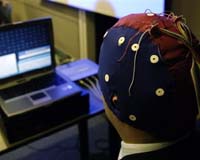An Adaptive Interface For Controlling The Computer By Thought
 A cerebral interface or brain-computer interface (BCI) (pictured) allows people with communication problems to relate to their surroundings using a computer and the electrophysiological signals from the brain. Photo courtesy of AFP. |
Navarro, Spain (SPX) Jun 15, 2006
Controlling a computer just by thought is the aim of cerebral interfaces. The engineer from Pamplona, Carmen Vidaurre Arbizu, has designed a totally adaptive interface that improves the performance of currently existing devices in, reducing the time needed to become skilled in their operation and enhance the control that users have over the interface.
Moreover, according to Ms Vidaurre, the majority of the population is capable of using it.
The results appear in the PhD thesis, Online Adaptive Classification for Brain-Computer Interfaces, defended recently at the Public University of Navarre.
Cerebral interface
A cerebral interface or brain-computer interface (BCI) allows people with communication problems to relate to their surroundings using a computer and the electrophysiological signals from the brain. The actual interface with which Carmen Vidaurre has worked with is based on electroencephalograms (EEG) of the individual, although there are others that use signals recorded from electrodes fitted directly into the brain.
The user and the interface are highly interdependent "systems" that, up to recently, adapted to each other independently. In the past, when a non-experienced individual started to use a BCI, the systems were unable to supply feedback, i.e. the individual was unable to see the results of their brain patterns on the screen.
With those outdated systems and, after a number of prior, data-collecting sessions, feedback was included and, in this way, the subjects started to adapt themselves to the computer, using the interface response to the patterns extracted from the signals.
However, few users could use these interfaces because the patterns generated during the trial sessions had to be greatly similar to those sessions with feedback.
One of the biggest problems found by other users and researchers into these "static" systems was that the patterns extracted from the signals recorded in the trial sessions were quite different from those signals recorded in the presence of feedback. For example, the visual input was different between both types of sessions and this difference significantly changes brain activity in specific areas thereof.
For inexpert users it is very difficult to adapt to the traditional interface because they are unable to generate stationary patterns in time, probably due to their inexperience. They find it very complicated to reproduce mental states sufficiently similar to be correctly classified.
Pioneering research
This is why, this PhD has designed, in a pioneering way, two in-line adaptive classifications, within a completely adaptive interface and capable of supplying feedback to inexpert individuals in the first stages of its use. With this system, the interface and the individual adjust to each other, one learning from the other in a reciprocal manner.
In this way it has been possible to eliminate the initial trial sessions without feedback, thus diminishing the total skills acquisition time and the individuals are able to find an operating strategy directly with feedback.
Moreover, the experiments carried out with individuals without prior experience, have demonstrated that the majority of the population are capable of learning to control an adaptive BCI. Specifically, in the trials undertaken with 30 persons in Austria and Pamplona, it was found that 20 had been able to control the interface "very well" within 4 hours.
Four modules
The interface is basically made up of four modules that take charge of, respectively, the acquisition and pre-processing of the signal; the extraction of its characteristics; the classification of the signal in the various patterns the interface possesses and, finally, the feedback, the stage in which it is tested whether the action has been the expected one or not.
This research has mainly focused on the classification module, dealing with identifying the type of signal that the subject is sending. In an interface that has, for example, two patterns (imagination of the movement of the left hand and of the movement of the right hand), the classification module tries to decide to which pattern the current signal belongs.
Related Links
Public University of Navarre
No comments:
Post a Comment